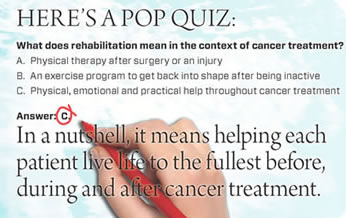Carrying on With Cancer

The U-M Rogel Cancer Center has spent nearly a decade developing programs and services to help patients with rehabilitation. We sat down with Patty Clark, M.S.N., R.N., director of the Rogel Cancer Center's Adult Survivorship Program, to talk about the broad scope of rehabilitation and how it should be a routine part of your care.
Q. Can you help Thrive readers understand what we mean by "rehabilitation?"
With rehabilitation, we try to help people with cancer function at their optimum levels in life based on any limits that may have resulted from their cancer diagnosis or treatment. Cancer rehabilitation addresses physical, social, emotional and work-related changes and helps each person set achievable goals to maximize his or her ability to carry on with life.
Q. Why has rehabilitation become a major issue in cancer care?
Cancer rehabilitation has been an objective of cancer care since the National Cancer Act in 1971. I think we are seeing more about it in the media because more and more people are living with cancer. Cancer survivors want to live like anyone else. They want to be active in their families, at work, at church and in the pursuit of their interests, just like they did before their diagnosis. However, successful cancer treatment may result in some changes, limitations perhaps, and people with cancer need help overcoming these as much as possible
Q. Does rehabilitation mean the same thing as survivorship?
Survivorship is a phase of your cancer care that begins after treatment. Rehabilitation is an ongoing aspect of cancer care. Rehabilitation can begin at diagnosis with something like, for example, quitting smoking before surgery. Restorative rehabilitation that usually takes place after treatment might include range of motion exercises after breast surgery or an exercise prescription to fight cancer-related fatigue. Supportive rehabilitation also takes place after treatment and can include physical rehabilitation like strengthening exercises after a long period of inactivity or learning to use a prosthetic limb after amputation, as well as psychological rehabilitation, which might include participating in a support group or one-on-one counseling. Palliative rehabilitation can take place throughout the cancer experience and involves treating symptoms related to cancer and its treatment.
Q. Can you tell Thrive readers about your desire to build a survivorship model at the Rogel Cancer Center that crosses all diagnoses?
The Rogel Cancer Center has expert doctors and nurses who provide excellent survivorship care to our patients and have done so for many years in multi-disciplinary clinics and select specialty clinics. We have three main goals for expanding our survivorship model to all areas:
First, we want to create treatment summaries and care plans for patients and their primary care providers. These will give patients a summary of their treatment and a plan for followup going forward. Patients will understand what is expected after treatment and who they should contact for various issues.
Secondly, we want to monitor each patient's quality of life and symptoms between visits with the goal to prevent a symptom that "isn't quite right" from becoming "urgent." We are building a system that will reach out to cancer survivors and ask them to tell us how they are doing using a variety of methods, from low-tech phone calls to high-tech applications on smart phones and mobile tablets.
Our third goal is to improve communication between the various health care providers a patient sees during care, specifically between oncology and primary care teams. Treatment summaries and care plans are not only for patients; they also help primary care doctors and other providers involved with the care of a cancer patient know exactly what treatment has been given and the plan of "who does what" for both patients and clinicians.
Q. Why is the topic of rehabilitation important to you?
Our population is aging, but is generally an active population and we should do our best to keep it that way. We want to help people with cancer be healthy and as active as possible. Cancer rehabilitation is one way to make that a reality.
Q. What would you say to a Rogel Cancer Center patient struggling with issues during or after cancer treatment?
I would encourage any Rogel Cancer Center patient who is struggling with issues during or after cancer treatment NOT to try to do it on their own. First, tell your doctor and your cancer care team. They are very engaged and eager to help in any way that they can. There are many services here at the U-M Rogel Cancer Center that provide a wealth of assistance for practical matters like prescription coverage issues, symptom management and psychosocial care. We also partner with others in the community who offer support groups for survivors. The first step is to talk with your treatment team and let them know what you are experiencing. They can help you find the help you need.
Read the Spring, 2013 issue of Thrive.
